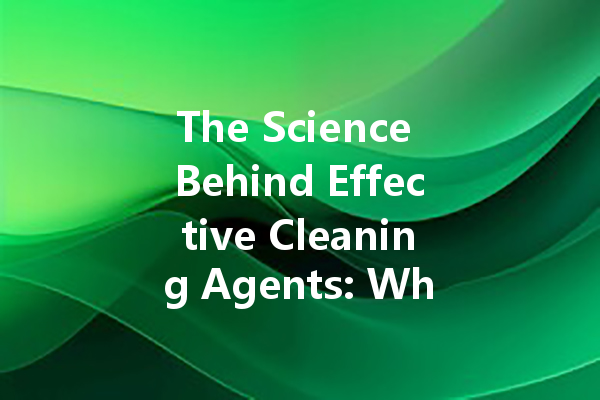Cleaning agents are essential products in our daily lives, often overlooked yet profoundly influential in maintaining hygiene, safety, and cleanliness in our environments. With a plethora of brands and types available in the market, understanding the science behind these products can help consumers make informed decisions. This article delves into the components, effectiveness, and innovations in cleaning agents.
Что такое чистящие средства?
Cleaning agents, also known as cleaning products, are substances designed to remove dirt, stains, and contaminants from surfaces. They often come in various forms, such as liquids, powders, or sprays, and are formulated to tackle specific cleaning tasks—whether that’s washing dishes, cleaning floors, or disinfecting surfaces.
The Core Components of Cleaning Agents
The effectiveness of cleaning agents hinges on their formulation, which typically includes the following essential components:
Поверхностно-активные вещества
Surfactants, or surface-active agents, play a pivotal role in cleaning agents. They work by reducing the surface tension of water, allowing it to spread and penetrate more effectively. By bonding with both water and grease, surfactants enable the easy removal of dirt and stains from surfaces.
Растворители
Solvents help dissolve and suspend dirt, making it easier to clean surfaces. Common solvents used in cleaning agents include isopropyl alcohol, ethanol, and various glycol ethers. Solvents can help in breaking down tough stains and residues.
Строители
Builders enhance the cleaning effectiveness of surfactants and are particularly useful in hard water conditions. They work by softening water, which allows the cleaning agents to perform better. Common builders include phosphates, citrates, and zeolites.
Ферменты
Enzymes are biological catalysts that enhance the cleaning process. They break down specific types of stains—such as protein-based stains (like blood) or starch-based stains. Enzymatic cleaners are especially popular in laundry detergents, as they can target and break down stains effectively without damaging fabrics.
The Importance of pH in Cleaning Agents
The pH level of a cleaning agent significantly impacts its effectiveness and safety.

Щелочные чистящие средства
Most household cleaners are alkaline, which helps to emulsify grease and oil, making them easier to remove. Alkaline cleaners generally have a pH level above 7 and include substances like sodium hydroxide and ammonia.
Кислотные чистящие средства
Acidic cleaners, with a pH level below 7, are effective in removing mineral deposits, rust, and stubborn stains. Examples include vinegar and citric acid, which are common in descaling products.
Нейтральные чистящие средства
Neutral cleaners have a pH of around 7 and are ideal for cleaning floors and surfaces without damaging them. They are often used for daily cleaning tasks in homes.
Understanding Labeling and Transparency
To choose the right cleaning agent, it is essential to understand the labels. Many cleaning agents provide detailed information about their ingredients, usage instructions, and safety warnings. Familiarizing oneself with product labels can help consumers make better choices that align with their cleaning needs and environmental concerns.
Экологически чистые варианты
The consumer demand for eco-friendly cleaning products has surged in recent years. Many manufacturers are adapting their formulations to include biodegradable ingredients, natural surfactants, and sustainable packaging to minimize environmental impact.
Соображения безопасности
Ensuring safety while using cleaning agents is critical. The use of personal protective equipment (PPE) such as gloves and masks is often recommended, particularly for products containing harsh chemicals. Moreover, proper storage and handling of cleaning agents are crucial to prevent accidents, especially in households with children or pets.
Инновации в области чистящих средств
As technology advances, so does the formulation and effectiveness of cleaning agents. Innovations such as microencapsulation, where cleaning agents are housed in tiny capsules that release upon contact with dirt, are making waves in the industry. Additionally, advancements in nanotechnology are leading to the development of ultra-efficient cleaning agents.
Умные чистящие средства
The latest trend in cleaning agents includes the creation of “smart” cleaning products equipped with sensors that react to dirt or odor, releasing specialized agents for targeted cleaning. These innovations not only enhance cleaning efficiency but also offer convenience to users.
Заключение
Understanding the science behind effective cleaning agents empowers consumers to make informed choices when selecting products for their homes or businesses. By recognizing the roles of surfactants, solvents, enzymes, and other components, individuals can choose products that suit their needs while promoting safety and sustainability. As manufacturers continue to innovate, the cleaning industry is poised for further advancements that will enhance cleaning efficacy and environmental responsibility.
